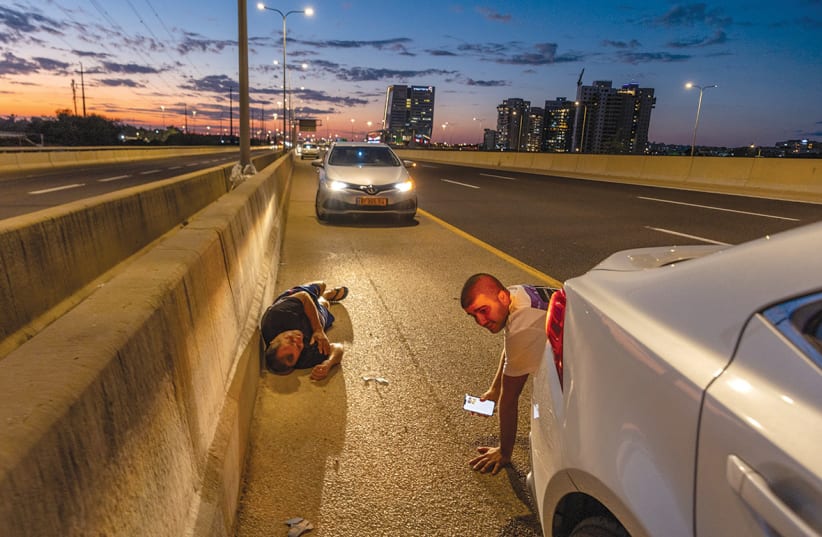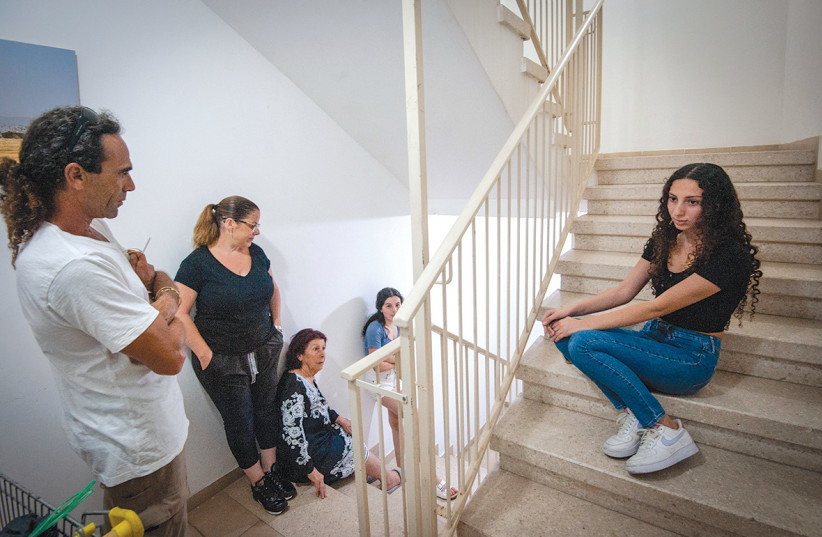
In the pre-dawn hours of Sunday morning, April 14, Iran launched an unprecedented volley of drones and missiles at Israel. Not like the relatively clumsy rockets of Hamas, these were precise and dangerous. And unlike the usual rocket fire, centered on the North and the South, these came from Iran, through Iraq, and into Jordan with the goal of hitting targets in Israel – and for many residents, Jerusalem looked like it was in their path.
Ultimately, the worst was averted. Operation Iron Shield, as it is now officially called, helped neutralize the incoming aerial threats before they reached Israeli airspace (barring one that hit the South), and Jerusalemites had nothing to fear. But sirens were heard across the city, and many “booms” from air defense system interceptions were heard before that. For many Jerusalemites, this was one of the scariest moments in recent memory.
Which is why it’s such a problem that not all Jerusalemites have safe rooms to go to when this happens.
Safe rooms are a common site all over Israel, whether they are public or in-home bomb shelters. Many buildings throughout the country have shelters on every floor, or even a safe room in each apartment. But Jerusalem is sorely lacking in this.
Despite the ongoing construction boom throughout the city, many buildings are very old. And due to the high cost of housing, that’s the only option available for many people.
My own apartment building, in the Katamon neighborhood, lacks any safe room. While many people rush to the stairwells of their building when this happens, plenty of buildings – such as my own – lack any real secure stairwell at all. Neither of my previous two apartments had any safe rooms either, providing no security should the worst come to pass.
And this is a far more common issue in Jerusalem than just affecting one person.
According to a report by MyNet Jerusalem in November, out of the capital’s nearly one million residents, almost half (48%) don’t have access to safe rooms. This gets even worse when considering public shelters.
According to the Jerusalem Municipality, there are 214 public shelters in the city. But they aren’t distributed evenly.
Most Jerusalemites without safe room access are in east Jerusalem or on the outskirts. For example, Pisgat Ze’ev and Ramot are Jerusalem’s two largest neighborhoods, with populations of more than 44,000 and 56,000, respectively. But according to the municipality’s website, neither one has a single public bomb shelter. Granted, some places have opened up safe rooms in schools or parking garages, but they aren’t accessible to everyone, especially with just a minute and a half to reach them.
By contrast, the Kiryat Hayovel neighborhood has over 20 public bomb shelters, some of them close to each other – some of them even listed at the same address – despite having less than half the population of Ramot.
BUT WHAT about the public shelters in Jerusalem proper? Despite the municipality listing them as there, it turns out that not all of them are usable. For instance, out of all the public bomb shelters in the Beit Hakerem neighborhood, 50% of them are listed on the municipality website as being temporarily inactive. This is also the case for 40% of all public shelters in Baka, 33% in Kiryat Moshe, and 100% in Musrara and Shuafat.
Regarding Musrara, according to a report by Kol Ha’ir, residents tried to use the public shelter, only to find that it was being used as a warehouse with municipality approval.
This wasn’t an isolated incident, either. On December 15, when sirens were heard in Jerusalem, people in Beit Hakerem rushed to the nearby shelter but found that it was locked, according to Kol Ha’ir.
“The public shelter near us to where we tried to run on October 7 has been locked the entire time, and the municipality says it’s out of order,” said Jerusalemite Gabriel Urbanowicz. “I think it’s probably time for them to be repairing all out-of-order shelters, especially given these crazy times.”
“There’s a terrible lack of bomb shelters throughout the city,” Jerusalem City Councilor Laura Wharton said in a previous interview with In Jerusalem. “East Jerusalem has just one, and many public ones were found to have a lot of maintenance problems.”
This severe lack of bomb shelters, especially in a city filled with old buildings without shelters at all, is nothing new. A municipality audit in 2021 noted that safe rooms were not being viewed as a priority by the city.
To address the issue of a lack of public bomb shelters, after October 7 the municipality bolstered security in the city with makeshift safe rooms, either in schools or in parking garages. That didn’t last for long, however, because they started being used again after a few weeks [for their original function], so they could no longer serve as adequate shelters.
But even if people had a public bomb shelter nearby, or even one in their building, it might still not be enough because it isn’t necessarily accessible.
“Our safe room is in the basement, down a lot of stairs, which I can’t manage,” said Jerusalem resident Jenny Zin. “So, I stay home.”
Others, such as the elderly or those with physical disabilities, are also out of luck in many cases. Old buildings are among the most affordable, and many of them lack elevators. As a result, it can often be physically impossible to make it to a safe room in time or at all, if one is even nearby.
This lack of accessibility reflects another issue – the lack of accessibility in Jerusalem as a whole. After all, this is a city where some of the Welfare and Social Services Ministry’s offices for disability aid aren’t even accessible, requiring people to walk up several flights of stairs.
THE ISSUES with lack of safe rooms goes beyond individual people.
In the early months of the war, school and university education was restricted to places that had safe rooms. This makes sense – and, in fact, schools are often the closest things many neighborhoods may have to a public safe room. But there are problems with this, too. Just a few weeks after the war started, one Jerusalem school wasn’t able to bring its students in because their shelter was being used as a classroom by another nearby school, as reported by MyNet Jerusalem.
And another issue is that not all schools even have safe rooms to begin with.
According to multiple media reports, the Yad Asher kindergarten in Gilo was forced to change buildings five times in just four months due to the war, moving in December to a building with no safe room. When asked what they would have to do in case of sirens, parents were reportedly outraged upon being told that the preschool-age children would be instructed on how to go outside and lie down on the ground.
At the time, the municipality said that this was all in line with directives from the Home Front Command; Jerusalem had been deemed safe enough for everyone to go back to school, including the temporary structures without safe rooms. And lying down on the ground is what the command recommends doing in cases where there aren’t any safe rooms accessible.
According to Kol Ha’ir, the parents of children at this school further criticized Safra Square for not only failing to properly keep them informed about all of this, but for not doing so despite claiming that they were in constant contact with the parents.
“It was reported that the municipality is in continuous contact with representatives of the parents,” they said, according to the report. “We would love to hear the names of these representatives because as of now, not a single parent has received any response from the municipality.”
These parents aren’t the only ones who have expressed concerns.
“I’d feel a little bit uneasy,” explained Gush Etzion resident Shlomo Jesin, a father of two whose wife is pregnant. “You want your safe room to be as accessible as possible.”
Jesin works as a cleaner in Jerusalem, and while many of his clients have safe rooms, not all of them do.
“If there were sirens, I’d run to the nearest shelter. I can make it in a minute and a half,” he said, “but not everyone can do that.”
SO WHAT can the municipality do? They’ve already done a few things, such as the shelters in schools and parking garages, but those aren’t usable anymore. They also tried to push legislation to make it easier to get permits to build safe rooms, but that hasn’t led to all old buildings being reinforced.
The best option, despite the highly controversial nature of it, seems to be more construction and urban renewal. Programs like TAMA 38 and Pinui u’Binui (demolition and construction) can help, as can construction of more new buildings that have safe rooms. But those come with issues, too. This construction isn’t happening everywhere, with the neighborhoods with the least amount of protection often being among the most neglected. Further, newer buildings tend to be very expensive, which can essentially make being safe a luxury.
Right now, the worst of it seems to be over. Iran hasn’t launched any more attacks, and Jerusalem is usually largely insulated from the rocket fire from Gaza and Lebanon. But it should be noted that this time, the Iranian attack was carried out from a distance, so Jerusalemites had several hours to prepare themselves in advance, making sure they were as safe as possible. But that isn’t always going to happen. Most of the time, there is only an extremely short window of time with which to get to safety, on the off chance that Israel’s air defense system doesn’t manage to intercept the incoming attack.
It remains to be seen if Jerusalemites will have better options than scrambling to find any nearby shelter – if they can and if there are any around – or just to hope for the best.■
Experiencing Iron Shield with nowhere else to go
I’ve been in Jerusalem for most of the Israel-Hamas war, and I was in Jerusalem when rockets were fired at us in 2021.
The immediate terror felt on April 13 and 14 was greater than any other.
As soon as we heard that drones and missiles were on their way to Jerusalem, a sense of dread and danger could be felt. I don’t live in a building with a bomb shelter, nor do I live in one with a secure stairwell. The closest safe rooms aren’t too far for the average person, but I have a physical disability and wouldn’t be able to make it in such a short amount of time.
But it’s not like I can go anywhere else.
Several months ago, as my lease was nearing its end, I was looking for a new apartment that was accessible, had a bomb shelter, and was reasonably priced. Unfortunately, none of those options existed. The real estate market in Jerusalem has never been good; but ever since the war started, it feels like the city is seeing more competition than ever. I have to factor in my commute to The Jerusalem Post’s office, proximity to a branch of my health fund, and a place where I could actually receive deliveries rather than the building’s address not being visible and no one being able to find the place.
With all that in mind, and prices rising, I had to stay right where I am now. And I don’t mind too much personally, as I love my apartment. But I’m lucky to have an apartment that I like; others aren’t so fortunate.
The lack of affordable housing has been a nationwide crisis for years, but when you factor in safe rooms, it goes beyond just a housing crisis – it’s a safety crisis. And it’s one that, hopefully, the municipality will find a way to address.


